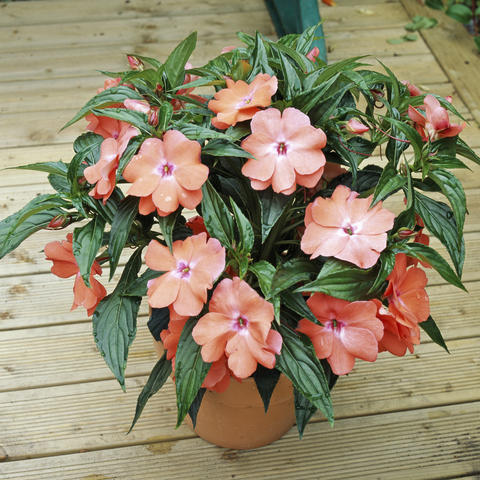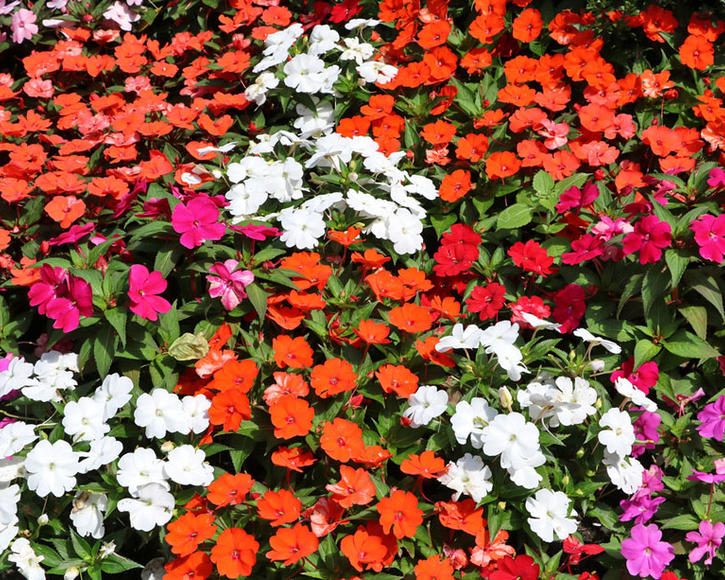Impatiens
Impatiens has leaves with strikingly pretty markings and colorful flowers. When cared for properly, they even bloom from spring to fall. Here’s what you need to keep in mind when planting.
Factsheet
- Growth type
-
- Perennial plant
- Growth height (from)
- from 20 cm to 40 cm
- Growth characteristics
-
- upright
- bushy
- Flower color
-
- purple
- yellow
- orange
- red
- pink
- white
- multicolored
- Flowering time (month)
-
- April to October
- Flower shape
-
- 5-fold
- Uniflorous
- Leaf color
-
- green
- page format
-
- elliptiques
- lancéolées
- Fruit shape
-
- Capsule
- Light
-
- semi-shade to shady
- Soil type
-
- sandy to loamy
- Soil Moisture
-
- fresh to moderately humid
- Lime compatibility
-
- lime-loving
- Nutrient requirements
-
- moderately nutritious
- Humus
-
- rich in humus
- Decorative or utility value
-
- Flower Decoration
- Toxicity
-
- non-toxic
- Winter Hardness
-
- frost-sensitive
- areas of life
-
- B2
- B3
- Use
-
- Flowerbeds
- Grave planting
- Planters
- Garden style
-
- Flower garden
- natural garden
- Pot garden
Botanically speaking, the most popular impatiens are New Guinea hybrids produced from years of intense cultivation. As the name suggests, the original plants come from the highlands of New Guinea and are part of the balsam, or touch-me-not, family (Balsaminaceae). They are very commonly seen as voraciously flowering, long-lasting balcony plants. Although they are technically perennials, these continuous flowerers are often only cultivated for one season in temperate zones: they are very sensitive to frost.
Impatiens grows upright and bushy. Its thick, fleshy shoots feature heavy branching. Its final height is between 7.87 and 15.75 inches, depending on the variety.
Impatiens stands out not only thanks to its cute flowers: its leaves feature fetching markings. The leaf blade may feature one or multiple colors. Their shapes are elliptical to lanceolate.
Impatiens flowers from April in some places but by the end of May at the latest, and the flowering period extends into October. The flowers are saucer-shaped, single or double and have a long spur. They grow to around 1.57 inches in diameter. The color of impatiens flowers ranges from white and light pink to dark pink and from purple to red and orange.
It’s clear to see that this plant is part of the touch-me-not family: impatiens forms capsule fruits after flowering that explode at the smallest touch, catapulting their seeds outwards.

Another benefit of growing impatiens: they prefer semi-shade to shade, where other plants would fail to thrive. But they must be protected.
Impatiens New Guinea hybrids thrive best in loose, permeable soil. Good drainage is very important when keeping this plant in a balcony container or pot. Substrate should be humus-rich and may contain lime.
Flowering this much is thirsty work! Regular watering – each morning and evening in hot, dry summers – is essential for impatiens.
If the substrate is suitable, then moderate feeding in the form of slow-release fertilizer should suffice.
Don’t put your impatiens outside too early: wait until there is no risk of late frost before you plant it out on your balcony or terrace or into your flower bed. This is the only way to prevent any late frost from damaging your plants. In practice, it has proven useful to pinch out impatiens shoots right at the beginning of its flowering period. This makes the plant bushier by promoting outward growth. The regular maintenance of impatiens includes deadheading. If you always remove dead flower heads, you will encourage the growth of new buds.
As already mentioned, frost-sensitive impatiens are usually only grown for one year in most zones due to weather restrictions. They can suffer serious damage under 50 degrees Fahrenheit. Young potted plants can survive winter indoors if they are moved inside at the right time and positioned in a bright, cool location with temperatures around 59 degrees Fahrenheit. Watering should be infrequent here, but the root ball should never be allowed to completely dry out. Impatiens New Guinea hybrids are also generally used as seasonal plants in beds: even with winter protection, it’s uncertain whether they will survive a cold winter in temperate climates.
Impatiens is perfectly suited to use in seasonal balcony containers, hanging baskets or pots on a terrace. With their long flowering periods, lasting from spring to fall, they are an aesthetic win in any case. Impatiens are great for combining with other members of the same genus, such as busy Lizzies, which have very similar needs. Decorative partners for shaded and low-light positions include fuchsias and tuberous begonias. They form a harmonious vignette in partial shade with fan-flowers or trailing lobelias. If you plant impatiens into a bed, leave 5.91 to 9.84 inches of distance between plants.

There are at least as many different colored impatiens as there are New Guinea impatiens hybrids. To put it another way: there’s an impatiens to suit almost everyone. For balconies and hanging baskets, low-growing varieties such as these are ideal:
- “Tango”: orange flowers, dark green leaves, grow to 7.87 to 12 inches tall,
- “Aglia”: pink flowers, green-yellow foliage, grow to 9.84 to 14 inches tall,
- “Samoa”: white flowers, green leaves, grow to 9.84 to 14 inches tall or
- “Trinidad”: red-purple flowers, dark green leaves, grow to around 14 inches tall.
Only a few New Guinea impatiens hybrids can be grown from seed. “Spectra” and “Tango” are two options. All impatiens can be propagated from cuttings. These are taken in spring and tend to root reliably when either left in water or put directly into a pot of soil.
Gray mold and root rot generally affect impatiens due to improper cultivation, especially waterlogging and overwatering. Common pests include spider mites and aphids.

